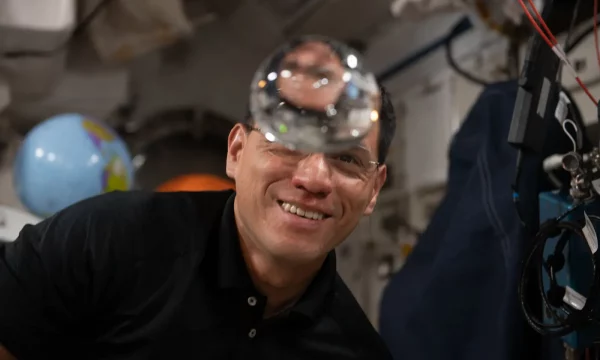
Living in Freefall: Understanding Why Astronauts are Weightless in Space
Last Updated: February 21, 2023
We have all seen and probably have felt envious of astronauts floating in space. It seems heavenly, magical, and so much easier than our life here on solid ground.
But why do they float in space? Why do they float on the International Space Station? Is that for the same reason? What is zero gravity/zero-g versus microgravity? And what is this thing called freefall?
Together, let’s explore these terms and their differences to better understand how astronauts float in space and on the International Space Station, how this affects living and working in space, and how we are studying the effects on our bodies and more to better provide safe, healthy working environments for our current astronauts and those on future longer-term space exploration missions.
The Physics of Weightlessness
Gravity is the attractional force that an object with mass has on another object of mass. The object with more mass will pull other objects with less mass toward it. The bigger the object, the greater the gravitational force it has. Here on Earth, our mass is pulled toward the Earth. We do not feel gravity unless there is a force contradicting it. The normal force is what we call the contact force acting upon objects that are physically associated with each other, and is the opposing force to gravity. When we are standing, Earth’s gravity pulls our body towards the ground, but the normal force pushes upward against our feet, helping us to perceive gravity as weight. We are adapted to Earth’s gravitational force so we don’t often notice it unless we are out of shape/ our muscles are underutilized, meaning our muscles have to work hard to counteract it.
Weightlessness is the state of being without apparent weight, so there is no feeling of a force acting on us, even though the force is acting on us.
Zero gravity is when you are in an environment where nothing is impacting you with its gravitational force. You are not close enough to be pulled into something or all the mass around was perfectly equal, canceling out gravitational forces. Gravity is weaker in empty space but since there are tiny particles dispersed throughout space, they still provide tiny gravitational forces.
An object in orbit is away from the more massive object enough and is constantly moving enough to not be pulled in, but not fast enough to overcome the larger object’s gravitational force. The object is constantly in freefall because gravity is the only force acting upon it since there is no atmosphere to cause atmospheric resistance (pushing into air molecules) or normal force from the ground or other supportive surfaces. They are constantly falling toward Earth at the acceleration of gravity, but the object is traveling fast enough that it ends up circling the larger object, like a ball swinging round and round a tetherball pole or the end of a string. Objects in orbit still experience a reduced gravitational pull from the planet, but freefall is the real reason they experience weightlessness, not due to a lack, or more accurately a reduced amount, of gravity.
We might experience weightlessness for a moment when we jump up into the air as we overcome gravity before we lose momentum and begin falling back down to Earth or when we jump on a diving board or trampoline. However, since astronauts in space are moving forward enough, they do not fall down toward Earth too quickly but also don’t launch out of orbit. We can replicate this effect as we talked about in “how astronauts train for weightlessness in space” with parabolic flights in a plane creating short time periods where weightlessness occurs. This is similar to freefall rides at amusement parks where you are dropped along a tall tower. While not recommended, if you let go of an object at the beginning of the fall, it would fall at the same acceleration as you, appearing to float.
We are actively studying the effects of weightlessness on the human body which has helped us better understand its impact on the human body and how to mitigate it. Some of these effects include:
- Loss of muscle mass since they deteriorate as from not being used to counteract gravity. (this explains why astronauts can struggle to walk after landing back on earth)
- Loss of mineral density in weight-bearing bones (about 1-1.5% on acreage per month in space)
- Fluid displacement, shifting upward to the head can
- Increase pressure on the eyes, causing vision problems such as blurriness
- Increase the risk of dehydration and kidney stones as the body is tricked into thinking it is carrying too much water
- Cause swelling in the chest and face
- Nauseating motion sickness called space adaptation syndrome which typically goes away on its own as your body adjusts, but medication can help regulate systems
- Dysregulated immune system, particularly weakening T cells that fight diseases, making it easier to develop allergies, skin rashes, and infections.
- Dysregulation of the microbiome
- Elongation of spinal cords, without gravity pulling them down and compressing them, causing them to grow a couple of inches taller, but may cause backaches
- Cardiovascular changes such as the heart doesn’t have to work as hard to pump blood throughout the body, but it also reduces aerobic capability, making the exercise harder
- Disorientation in our vestibular sense which helps us understand where we are in three-dimensional space, causes dizziness and confusion
How the International Space Station (ISS) Achieves Weightlessness
The International Space Station (ISS) orbits Earth at an average altitude of 250 miles (400 km) at 17,150 miles per hour (27,600 km per hour). Being above Earth’s surface means the effect of Earth’s gravity is lessened, but only to about 90% of the gravity on the surface. The ISS is constantly falling toward Earth’s surface due to the pull of gravity. However, it is also moving away fast enough to perfectly match the way Earth’s surface curves, allowing it to perpetually fall around the planet, just as the moon is perpetually falling around Earth in its orbit. Maintaining this sideways velocity around the planet using thrusters if necessary (and reverse thrusters to slow down or drop in altitude as there are no brakes in space) ensures that freefall continues.
As we’ve discussed in previous articles, weightlessness has both positive and negative effects on living and working. It’s easier to move around, allowing you to float down the ISS with very little effort, but can also cause difficulties and confusion. You can’t simply put something down in space as it will float and due to the life support and air circulation system, it will likely be pushed away by air currents. Everything (including your body, food, and liquid) needs to be tethered to a surface to prevent floating away, meaning cleaning in space is highly important to keep everything safe, working properly, and healthy (both for equipment and living beings).
To prepare for these challenges, astronauts train for reduced gravity environments on Earth before leaving for space utilizing weightlessness sessions in the “Vomit Comet” parabolic flights and underwater replicas in the Neutral Buoyancy Lab. While there is nothing like living and working in space 24/7, this training prepares astronauts for space as much as they can ahead of time under the tutelage of veteran spacefarers.
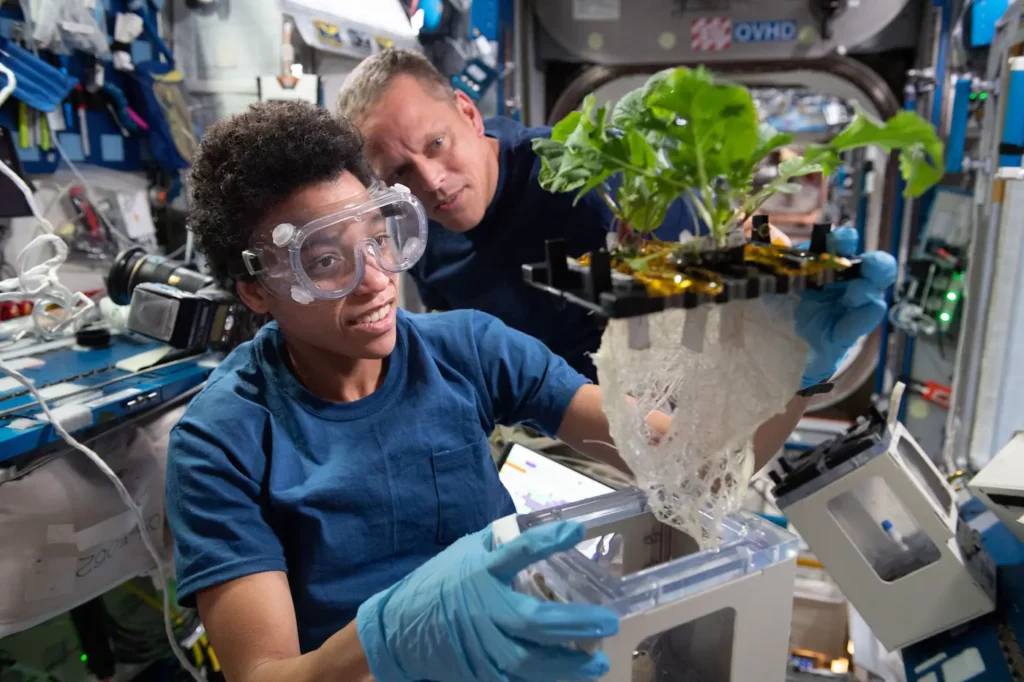
Astronauts Jessica Watkins and Bob Hines conducting scientific experiments whilst in freefall onboard the ISS. Credit: NASA
The Benefits and Risks of Weightlessness
Weightlessness can help us study the effect of weight, or apparent lack thereof, on living systems such as plants, animals, and even bacteria which can help us prepare for future space exploration missions such as to the Moon or Mars. This type of research can also help us understand how life evolved here on Earth and how this evolution might be different in environments with different levels of gravity compared to ours.
Weightlessness can help with the logistics of research since once the material is in space, moving them is essentially effortless, though again, this can cause other problems. It can also help us study how equipment is affected by gravity, helping us prepare space technology such as telescopes, probes, and more for launch. Gravity affects everything on Earth and therefore they react differently when the gravity is different. Flames are more round, crystals grow more uniformly, and more.
We are still studying the risks of long-term exposure to weightlessness since we only send astronauts up for very specific periods of time. Scott Kelly broke the record for longest consecutive days in space for an American astronaut at 340 consecutive days in space in 2016, with particular research being done comparing his body to his twin brother, Mark Kelly, who stayed here on Earth. Last year, Mark Vande Hei officially broke Scott Kelly’s record with 355 days. However, Valery Polyakov holds the world record with 438 consecutive days from 1994-1995. Peggy Whitson currently holds the record for total cumulative days in space (total over multiple missions) at 665 days.
As discussed earlier, weightlessness greatly affects many of the body’s systems including musculoskeletal (muscles and bones), cardiovascular/ circulatory (heart and blood vessels that deliver oxygen and nutrients throughout the body), immune (ability to fight infection), microbiome, and the vestibular (helps us understand where we and the parts of our body are in space).
Our body is an amazing system and does its best to adapt to new situations, meaning the worst symptoms are experienced at the beginning of the mission and typically decrease over time. However, the loss in muscle mass and mineral density, fluid shifts to the eyes, and cardiovascular effects on aerobic function can be particularly worrisome over time as it accumulates, especially when measures are not taken to mitigate the effects. Space agencies closely monitor astronaut health before, during, and continually after trips to space to best understand these effects, even “grounding” astronauts once health issues from prolonged time in space prevent further damage.
Longer space exploration missions such as to our Moon and Mars are of particular concern in terms of the effect of reduced gravity on the body. While they will not be weightless on the surface, the gravity on the Moon is 1/6th that of ours and Martian gravity is 1/3rd of ours. It is also worth noting that a trip to Mars would take about 7 months in the microgravity of space, with a 30-day surface mission (as released last year), and the trip back, this is a mission time of around 457 days which is almost 20 days over the current world record of consecutive days in space and requires multiple changes in gravity. Space agencies and private companies are currently gathering all the data they can, running simulations, and running experiments to plan as effectively as possible for these upcoming longer space exploration missions.
Since we’ve had continuous human occupation in space on the ISS for over 20 years, space agencies have learned how to mitigate the adverse effects of microgravity on their astronauts currently and are constantly researching better methods. They tackle many of the musculoskeletal effects by having astronauts keep to a proper nutritional diet and special exercise routines with specialized equipment that provide their muscles with extra work.
By working these muscles more and supplementing bone-healthy vitamins, minerals, and medicines such as potassium citrate (to decrease kidney stone development) and bisphosphonate (to prevent bone loss), they help to combat deterioration and help them better prepare for their return to Earth. Compression cuffs on the thighs and lower-body negative pressure devices help to counteract the fluid shifts and keep blood in the lower extremities.
Each astronaut is paired with at least one medical professional to discuss their health on a regular basis to help mitigate any problems that arise. Some of these tests include periodic fitness self-evaluations, software-generated workout partners to maximize workout effectiveness, urine tests to analyze how the body is processing nutrients, functional task testing to help detect and improve balance control, and fine motor skills testing to detect changes in their ability to react and interact with inputs. Astronauts are consistently testing new methods that could help them stay healthier including whether centrifuge artificial gravity may help in the future.
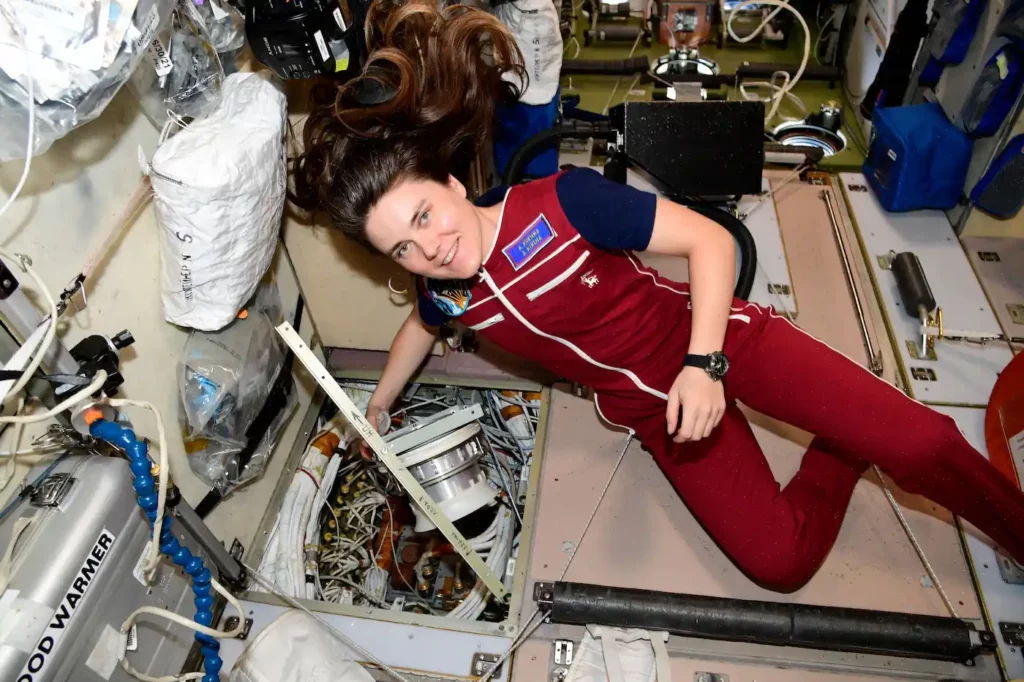
Cosmonaut Anna Kikina works on preventive maintenance aboard the International Space Station. Credit: NASA
The Benefits and Risks of Weightlessness
Weightlessness can help us study the effect of weight, or apparent lack thereof, on living systems such as plants, animals, and even bacteria which can help us prepare for future space exploration missions such as to the Moon or Mars. This type of research can also help us understand how life evolved here on Earth and how this evolution might be different in environments with different levels of gravity compared to ours.
Weightlessness can help with the logistics of research since once the material is in space, moving them is essentially effortless, though again, this can cause other problems. It can also help us study how equipment is affected by gravity, helping us prepare space technology such as telescopes, probes, and more for launch. Gravity affects everything on Earth and therefore they react differently when the gravity is different. Flames are more round, crystals grow more uniformly, and more.
We are still studying the risks of long-term exposure to weightlessness since we only send astronauts up for very specific periods of time. Scott Kelly broke the record for longest consecutive days in space for an American astronaut at 340 consecutive days in space in 2016, with particular research being done comparing his body to his twin brother, Mark Kelly, who stayed here on Earth. Last year, Mark Vande Hei officially broke Scott Kelly’s record with 355 days. However, Valery Polyakov holds the world record with 438 consecutive days from 1994-1995. Peggy Whitson currently holds the record for total cumulative days in space (total over multiple missions) at 665 days.
As discussed earlier, weightlessness greatly affects many of the body’s systems including musculoskeletal (muscles and bones), cardiovascular/ circulatory (heart and blood vessels that deliver oxygen and nutrients throughout the body), immune (ability to fight infection), microbiome, and the vestibular (helps us understand where we and the parts of our body are in space).
Our body is an amazing system and does its best to adapt to new situations, meaning the worst symptoms are experienced at the beginning of the mission and typically decrease over time. However, the loss in muscle mass and mineral density, fluid shifts to the eyes, and cardiovascular effects on aerobic function can be particularly worrisome over time as it accumulates, especially when measures are not taken to mitigate the effects. Space agencies closely monitor astronaut health before, during, and continually after trips to space to best understand these effects, even “grounding” astronauts once health issues from prolonged time in space prevent further damage.
Longer space exploration missions such as to our Moon and Mars are of particular concern in terms of the effect of reduced gravity on the body. While they will not be weightless on the surface, the gravity on the Moon is 1/6th that of ours and Martian gravity is 1/3rd of ours. It is also worth noting that a trip to Mars would take about 7 months in the microgravity of space, with a 30-day surface mission (as released last year), and the trip back, this is a mission time of around 457 days which is almost 20 days over the current world record of consecutive days in space and requires multiple changes in gravity. Space agencies and private companies are currently gathering all the data they can, running simulations, and running experiments to plan as effectively as possible for these upcoming longer space exploration missions.
Since we’ve had continuous human occupation in space on the ISS for over 20 years, space agencies have learned how to mitigate the adverse effects of microgravity on their astronauts currently and are constantly researching better methods. They tackle many of the musculoskeletal effects by having astronauts keep to a proper nutritional diet and special exercise routines with specialized equipment that provide their muscles with extra work.
By working these muscles more and supplementing bone-healthy vitamins, minerals, and medicines such as potassium citrate (to decrease kidney stone development) and bisphosphonate (to prevent bone loss), they help to combat deterioration and help them better prepare for their return to Earth. Compression cuffs on the thighs and lower-body negative pressure devices help to counteract the fluid shifts and keep blood in the lower extremities.
Each astronaut is paired with at least one medical professional to discuss their health on a regular basis to help mitigate any problems that arise. Some of these tests include periodic fitness self-evaluations, software-generated workout partners to maximize workout effectiveness, urine tests to analyze how the body is processing nutrients, functional task testing to help detect and improve balance control, and fine motor skills testing to detect changes in their ability to react and interact with inputs. Astronauts are consistently testing new methods that could help them stay healthier including whether centrifuge artificial gravity may help in the future.
Conclusion
While it is common to hear people discussing the zero-g environment of space, this isn’t accurate. Even in the remotest areas of space, there are tiny gravitational forces from molecules. However, the impact of gravitational force is impacted by how massive the object is and how close you are to it. Here on the surface of Earth, we are pulled toward Earth’s core, but pushed back due to the natural force of the ground beneath us and our muscles working against gravity.
However, as we move away from Earth, that gravity lessens, and yet, on the ISS, there is still 90% of the gravity that we experience on Earth. Weightlessness is the apparent feeling of having no weight and astronauts and everything else on the ISS experience weightlessness since the space station is in freefall around the planet, meaning it is constantly falling toward Earth but going at the speed that lines up with the Earth’s curve, meaning it’s not slow enough to fall out of orbit and not fast enough to launch away.
Weightlessness has many effects on the human body, other living creatures, and systems, as well as on equipment. While some of these effects are beneficial such as making things easier to move, many are detrimental especially to our health including deteriorating our muscle and bone mass, weakening our immune system, and more. Space agencies have been studying these effects to provide the healthiest and safest environments for astronauts and their equipment. They continue to push the limits responsibly to better understand how we will be affected on longer-term space exploration missions such as to our Moon and Mars.
We are all learning and it is fascinating to see the research and advancements. Today’s level of technology allows us easy access to it so feel free to explore our other astronaut, astronomy, and stargazing articles, as well as resources from NASA, other space agencies, and more.

Sarah Hoffschwelle is a freelance writer who covers a combination of topics including astronomy, general science and STEM, self-development, art, and societal commentary. In the past, Sarah worked in educational nonprofits providing free-choice learning experiences for audiences ages 2-99. As a lifelong space nerd, she loves sharing the universe with others through her words. She currently writes on Medium at https://medium.com/@sarah-marie and authors self-help and children’s books.
Explore more astronaut stories 👨🚀
This page is part of our collection of articles about astronauts. If you enjoyed the read, then you’ll love the following articles.
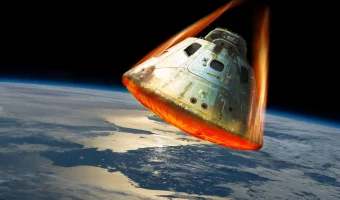
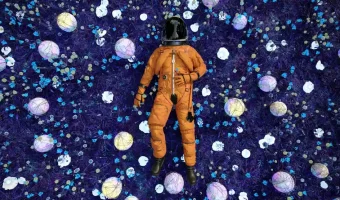

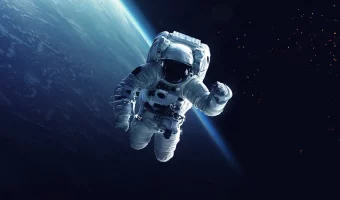
There are three main reasons why astronauts may have difficulty walking on land after spending so much time in a microgravity environment.
